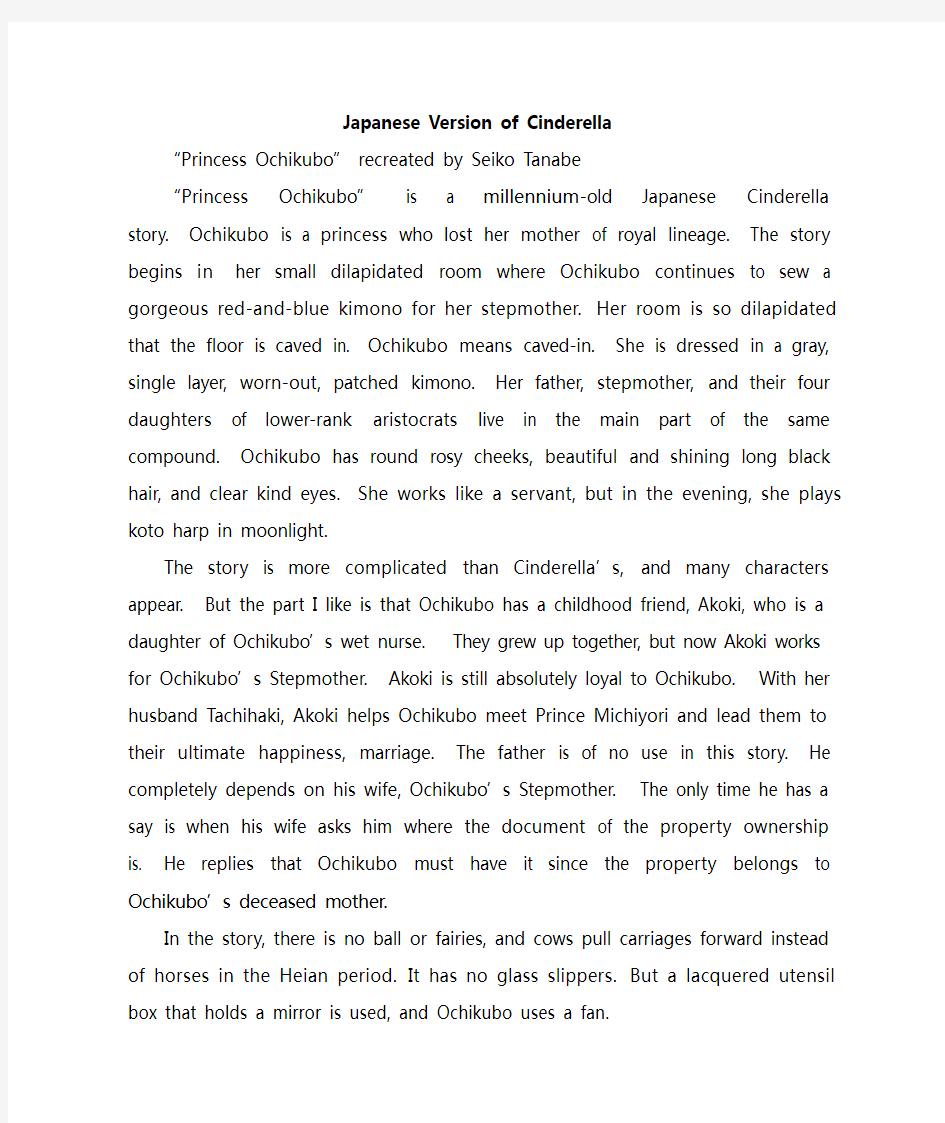Japanese_version


Japanese Version of Cinderella
“Princess Ochikubo” recreated by Seiko Tanabe
“Princess Ochikubo” is a millennium-old Japanese Cinderella story. Ochikubo is a princess who lost her mother of royal lineage. The story begins in her small dilapidated room where Ochikubo continues to sew a gorgeous red-and-blue kimono for her stepmother. Her room is so dilapidated that the floor is caved in. Ochikubo means caved-in. She is dressed in a gray, single layer, worn-out, patched kimono. Her father, stepmother, and their four daughters of lower-rank aristocrats live in the main part of the same compound. Ochikubo has round rosy cheeks, beautiful and shining long black hair, and clear kind eyes. She works like a servant, but in the evening, she plays koto harp in moonlight.
The story is more complicated than Cinderella’s, and many characters appear.But the part I like is that Ochikubo has a childhood friend, A koki, who is a daughter of Ochikubo’s wet nurse. They grew up together, but now Akoki works for Ochikubo’s Stepmother.Akoki is still absolutely loyal to Ochikubo. With her husband Tachihaki, Akoki helps Ochikubo meet Prince Michiyori and lead them to their ultimate happiness, marriage. The father is of no use in this story. He completely depends on his wife, Ochikubo’s Stepmother.The only time he has a say is when his wife asks him where the document of the property ownership is. He replies that O chikubo must have it since the property belongs to Ochikubo’s deceased mother.
In the story, there is no ball or fairies, and cows pull carriages forward instead of horses in the Heian period. It has no glass slippers. But a lacquered utensil box that holds a mirror is used, and Ochikubo uses a fan.
The key to the story is the same as Cinderella. It’s a perfect romance.No serious love competition appears. After Prince Michiyori meets Ochikubo, no girlfriend or ex-girlfriend appears. And Akoki and Ochikubo make the point that Prince Michiyori must promise that he will not look for another lover ever. He must love Ochikubo only. They repeat this to Prince Michiyori, and Prince expresses his true love for Ochikubo, and she is the only one for the rest of his life. He makes his vow. I love this part.
Unlike “The Tale of Genji,” “Princess Ochikubo” has some crude and gross moments. I think a lower-rank male aristocrat wrote this story, definitely not a woman. For instance, on a cat-and-dog rainy night, Prince and Tachihaki travel together to where Ochikubo and Akoki live. On the way there, they walk in the pitch darkness and meet a party of suspicious guards. They struggle with them, trying to escape and slip over cow-dab. And in another parallel plot, Stepmother pushes Ochikubo to marry their old and useless doctor after she learns about Prince’s interest in Ochikubo.Stepmother wants her fourth daughter to marry Prince. The dirty old doctor likes Stepmother’s idea, and he is deliriously happ y. He approaches the door of Ochikubo’s room at night.The weather is very cold, and the door is locked. The old man cannot wait. He eventually gets diarrhea, fleeing from the scene. Seiko Tanabe’s dialogues are brilliant.She wrote the doctor’s wo rds in Osaka dialect. They were hilarious. The way the doctor exclaims his joy is “Goo heeheeheeheeheehee” I broke into laughter reading it.
